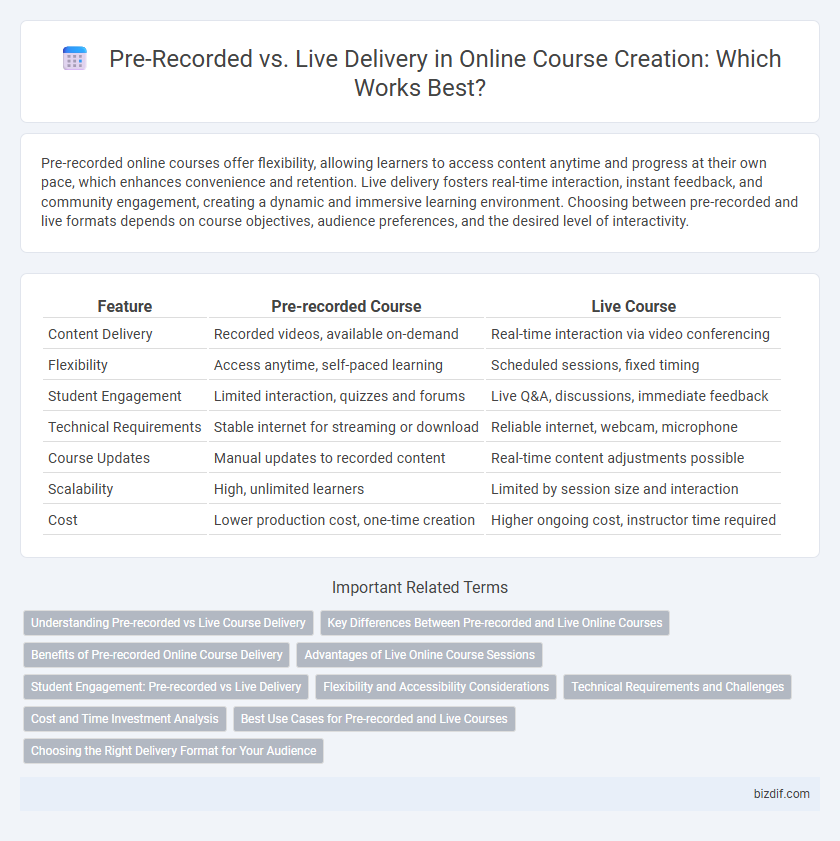Pre-recorded online courses offer flexibility, allowing learners to access content anytime and progress at their own pace, which enhances convenience and retention. Live delivery fosters real-time interaction, instant feedback, and community engagement, creating a dynamic and immersive learning environment. Choosing between pre-recorded and live formats depends on course objectives, audience preferences, and the desired level of interactivity.
Table of Comparison
| Feature | Pre-recorded Course | Live Course |
|---|---|---|
| Content Delivery | Recorded videos, available on-demand | Real-time interaction via video conferencing |
| Flexibility | Access anytime, self-paced learning | Scheduled sessions, fixed timing |
| Student Engagement | Limited interaction, quizzes and forums | Live Q&A, discussions, immediate feedback |
| Technical Requirements | Stable internet for streaming or download | Reliable internet, webcam, microphone |
| Course Updates | Manual updates to recorded content | Real-time content adjustments possible |
| Scalability | High, unlimited learners | Limited by session size and interaction |
| Cost | Lower production cost, one-time creation | Higher ongoing cost, instructor time required |
Understanding Pre-recorded vs Live Course Delivery
Pre-recorded course delivery offers flexibility by allowing learners to access content anytime, supporting self-paced learning and consistent quality through edited materials. Live course delivery fosters real-time interaction, immediate feedback, and dynamic discussions, enhancing learner engagement and community building. Choosing between pre-recorded and live formats depends on course objectives, audience needs, and desired learning outcomes.
Key Differences Between Pre-recorded and Live Online Courses
Pre-recorded online courses offer flexible access, allowing learners to engage with content at their own pace, while live courses provide real-time interaction and immediate feedback. Pre-recorded sessions ensure consistent quality and easy updates, whereas live courses foster dynamic discussions and greater engagement through direct instructor presence. The choice between pre-recorded and live delivery depends on learner preferences, course objectives, and the need for interactivity versus convenience.
Benefits of Pre-recorded Online Course Delivery
Pre-recorded online course delivery offers flexible access, allowing learners to engage with content at their own pace and revisit complex topics for better understanding. It enables instructors to ensure high-quality production, reducing technical issues and maintaining consistent delivery. Cost-effectiveness and scalability make pre-recorded courses ideal for reaching a global audience without the constraints of scheduling live sessions.
Advantages of Live Online Course Sessions
Live online course sessions enable real-time interaction between instructors and students, fostering immediate feedback and personalized support. This format enhances engagement through dynamic discussions, live demonstrations, and spontaneous Q&A, which deepen understanding and retention. Moreover, scheduled live classes promote accountability and motivation, helping learners stay on track and complete the course successfully.
Student Engagement: Pre-recorded vs Live Delivery
Live delivery enhances student engagement through real-time interaction, immediate feedback, and dynamic discussions that foster a sense of community. Pre-recorded courses offer flexibility and allow learners to learn at their own pace but often lack the spontaneous interaction critical for active participation. Incorporating interactive elements like quizzes and discussion forums in pre-recorded formats can partially bridge the engagement gap seen in comparison to live sessions.
Flexibility and Accessibility Considerations
Pre-recorded online courses offer unparalleled flexibility by allowing learners to access content anytime and from any device, accommodating diverse schedules and time zones. Live delivery fosters real-time interaction and immediate feedback, enhancing engagement but requiring synchronized availability, which can limit accessibility for some students. Balancing both methods addresses varied learner needs, optimizing accessibility without compromising flexibility.
Technical Requirements and Challenges
Pre-recorded online courses require reliable recording equipment, editing software, and sufficient storage capacity to ensure high-quality content and seamless playback, while minimizing technical glitches for learners. Live delivery demands stable high-speed internet, robust streaming platforms, and real-time interaction tools to support smooth communication and immediate troubleshooting during sessions. Both formats face challenges such as latency issues, device compatibility, and ensuring accessibility features to accommodate diverse learner needs.
Cost and Time Investment Analysis
Pre-recorded online courses require higher upfront time investment for content creation and editing but offer scalable, low ongoing costs due to automated delivery. Live course delivery demands continuous time commitment for real-time teaching and interaction, resulting in higher recurring time costs but potentially lower initial production expenses. Evaluating the balance between initial production effort and ongoing resource allocation is essential for optimizing cost efficiency in online course creation.
Best Use Cases for Pre-recorded and Live Courses
Pre-recorded courses are ideal for learners seeking flexible schedules and self-paced study, enabling content creators to produce high-quality, polished materials reused across multiple cohorts. Live courses excel in interactive environments requiring real-time engagement, such as workshops, Q&A sessions, or collaborative projects, where immediate feedback enhances the learning experience. Selecting between pre-recorded and live delivery depends on course objectives, audience needs, and the desired level of interaction to maximize learner retention and satisfaction.
Choosing the Right Delivery Format for Your Audience
Choosing the right delivery format depends on your audience's preferences, learning styles, and schedule flexibility. Pre-recorded courses offer convenience and self-paced learning ideal for busy professionals, while live sessions foster real-time interaction and community engagement, suiting learners who value immediate feedback. Analyzing your audience demographics and engagement needs ensures your course format maximizes retention and satisfaction.
Pre-recorded vs Live delivery Infographic

 bizdif.com
bizdif.com